Social media has too many things to offer to brands and users. That’s why if you want your audience to reciprocate, you need to mention it explicitly.
Create your social media marketing strategy in such a way that it propels maximum people to complete their sales journey and convert into your customers.
The simple hack is to add a CTA that creates a sense of urgency in them. Studies have shown that adding a CTA button increased conversion rates by a whopping 83%.
A call-to-action can be a slight nudge for commenting on your social media posts or the final call to sign up for a free trial. You can even use social media CTA to distribute your gated content, like downloading an ebook, templates, a checklist, or more.
A killer social media CTA can help you achieve all of these goals and maximize return. You need it to prompt your readers and viewers to take action on your site and social media, thereby enhancing your social media conversion rate overall.
But creating a killer call-to-action that converts is an uphill task. Outlined in this blog are the steps to create a CTA with a higher click rate and brand examples that are implementing it the right way.
Let’s explore!
What is a Call-To-Action (CTA)?
I’m sure you have seen buttons like, Read more, Take me there, Sign Up, Do it, or other such versions on various sites, prompting you to take action. These are called CTAs, a button that simply means to ‘call’ you ‘to’ take an ‘action’.
CTAs motivate your readers to interact with your content by taking actions such as clicking a button, signing up, liking, sharing, or commenting. As you can see in this example from SocialPilot’s Facebook page, click through to read a blog post.
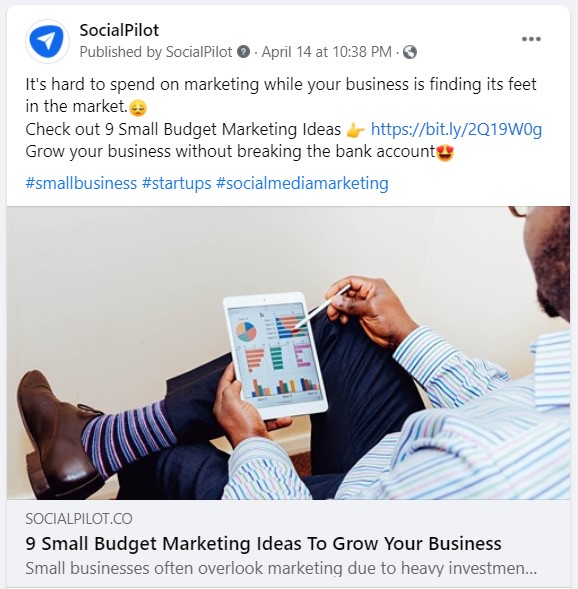
The value of CTA
If your followers are not taking action, the best you’re accomplishing is creating brand awareness. Brand awareness is valuable in itself.
But, if you get your audience to interact with your work, it will help you get a step closer to a higher return on investment. That means turning your passive viewers into active participants.
Types of CTA
Effective calls-to-action are simple and easy to follow. They come in a variety of types. They could be for lead generation, form submission, lead nurturing, or social sharing.
Although all CTAs might not lead to purchase, they should all be focused on generating engagement on websites and social media for your offerings.
Examples of some of the most popular types of CTA are:
- Opportunities to sign up for newsletters
- Share buttons for social media
- Social media links to your profiles
- Contact buttons
These fundamentals might sound like common sense. But a lot of marketers forget these basics when they’re caught up in the process of creating social media content. So just in case, here are some quick pointers:
1. Think about tone
The internet is full of noise, and your audience can easily get distracted by it. It is important to hold their attention and guide them through the processes of signing up, shopping on your site, and choosing your product.
Your CTA can garner their focus on you without any hint of intrusive and sales-y feeling. Nobody wants to be bombarded with ‘Buy Now!’ signs when they’re just trying to access needed information.
If you are looking for engagement and conversation, try inviting people like ‘We Want To Hear From You’, or ‘Join Our Community’.
If you want to alert clients and customers for upcoming sales, you can have a FOMO-driven CTA. ‘Buy Now’ might sound too pushy, but ‘Don’t Miss It’ can give a sense of urgency you’re looking for.
If you’re trying to pass on important information or you’ve got an exciting story to draw in readers, a quote from the piece with a ‘Read More’ will be a good CTA. It can drive traffic to your blog, serve as a credible source of information, and even help you establish brand authority.
2. Focus on your goals
Before thinking about your triggers, zero down what action in specific you’re trying to get out of them. The most effective CTAs guide your audience through the process of making a purchase.
Your marketing team, sales team, and social media team will have to work together to define this process and set goals accordingly. And then plan social media posts and CTAs to help you achieve these goals. For instance, you might create posts to generate engagement, including:
- Driving sales and sign-ups to your landing page
- Encouraging user-generated content
- Drive conversations and comments
- Alert readers of sales, discounts, and promotional events
…and much more!
The call-to-action would then be decided as per these goals.
If you have not set your goals yet, don’t fret about it. You can use these goals as a reference point for setting your own.
Use social media analytics tools like SocialPilot to analyze and track the social media posts that lead to the top engagement rates and the type of interaction you’re most interested in cultivating. That makes it easier to adjust your social media marketing strategy as you expand.
Also, it is important to strategize your content goals in an organized manner. Using social media calendar tools, you can organize and quickly figure out the motive behind each post and add a suitable CTA alongside.
To help you understand this better, we’ve outlined different types of CTAs and the type of engagement they create.
Certain action triggers typically involve taking smaller steps, gradually leading clients and customers toward an end goal.
Social media is a place for short, punchy, and visual-heavy messages to connect with your audience. The beauty of social media is that by its nature, it’s already encouraging engagement.
But there is a downside to that. You have to really think about channeling the most attention to your brand and rising above the noise.
So here are a few social media strategies that will help you hit the nail right. Learn how to apply these killer strategies to your social media branding and engage your followers.
1. Issue a challenge: Wendy’s
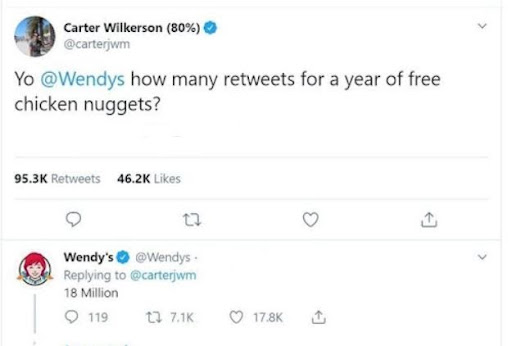
Wendy’s Twitter is legendary as a social media strategy, and it works wonders for their bottom line. Wendy’s engagement on Twitter usually averages at 10,000 shares and 30,000 likes. Not bad for a fast-food chain!
Wendy’s secret? Witty, clear, and fantastic customer service.
Take the #NuggetsforCarter movement. It started when a Wendy’s customer asked how many retweets he’d have to get for free nuggets for a year. Wendy’s set the number, and Carter’s original Tweet became one of the most retweeted tweets of all time!
Think about your own social media engagement. Are you interacting with customers in a way that encourages sharing?
Are you engaging with others in your field and developing a strong voice?
Wendy’s encouragement for one person to get 18 million shares brought more attention to their brand in quite a unique way.
2. Create a sense of urgency: Wix

Wix is a top website hosting service. The company found a great way to boost its social media profile with a huge $10K giveaway on Facebook to celebrate the Super Bowl.
Wix found plenty of ways to track their engagement with analytics tools like Buzzsumo, HubSpot, and Google Analytics. The ‘Win 10K’ call-to-action was enough to get people’s attention and increase engagement drastically.
You can create a similar sense of urgency with giveaways or exclusive content coupled with a limited-time offer.
Offering the chance to win a prize, combined with the time crunch (in this case, you’re literally watching the time pass), is a surefire way to interest viewers. And an arresting visual doesn’t hurt either!
3. Choose an impactful tone: Deadpool Movie
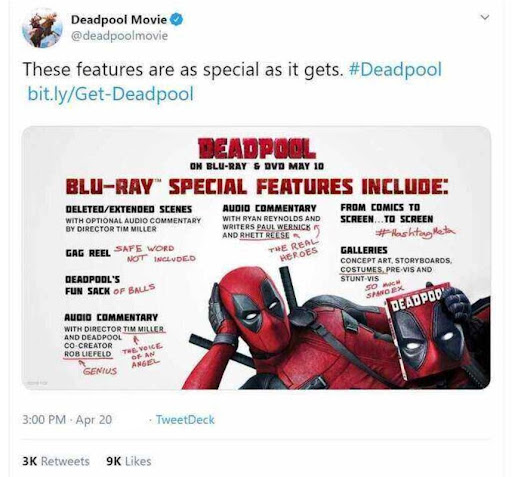
Deadpool makes great social media content, thanks to the strong personality of the main character.
For the release of the Deadpool DVD, the company launched a multi-channel social media blitz that capitalized on Deadpool’s blunt and inappropriate humor. That worked perfectly for a social media campaign.
It made it memorable, noticeable, but also short and to the point.
Rather than using a traditional call-to-action, Deadpool stays on brand and brings attention to the release with the Deadpool hashtag and a vaguely inappropriate joke that gets your attention.
Developing a strong, cheeky online voice can help you choose unique calls-to-action that can slip under the radar while still driving engagement.
4. Ask a fun, polarizing question: Netflix
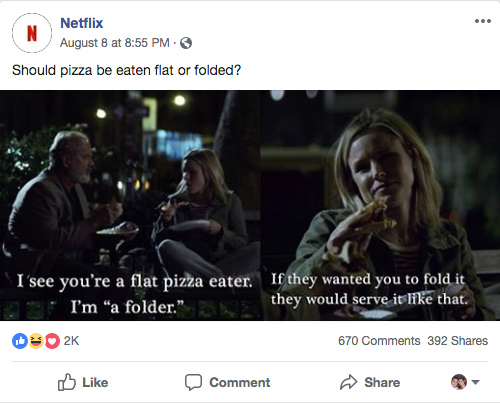
Netflix has a stellar social media strategy. They bank on their free trial and the simplistic design of their landing page. But they are quite innovative in aspects of conversational promotion.
Why? Apart from being a master of memefication, especially when it comes to their own movies and TV, Netflix uses easy, daily life questions that divide folks to trigger engagement. You can utilize a similar technique and spark an opinionated conversation thread for more interaction.
5. Use a pop culture connection: Eggo
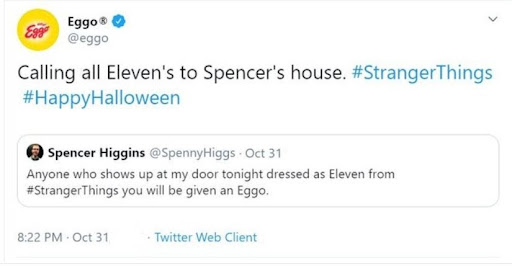
If you’re a fan of Stranger Things, you likely saw the Twitter campaign by Eggo Waffles, connecting them to the release of Stranger Things.
Eggo released Stranger Things-inspired posts across their social media handles, including videos of every Eggo scene in the series so far and suggestions for 1985-inspired Eggo menus. The partnership allowed them to stay away from traditional calls-to-action while capitalizing on current trends.
By offering quality content that included giveaways and special retro boxes, the campaign gave fans of both Stranger Things and Eggo Waffles plenty to talk about!
Think about your own partnerships. Who can be related to your brand? Do they have viewers you can tap into? What about current pop culture?
You might be a smaller company without expensive partnerships. But using search analytics, you can create calls-to-action relevant to certain events or interests throughout the year and capitalize on current trends with seasonal offers.
6. Use active voice: Nike
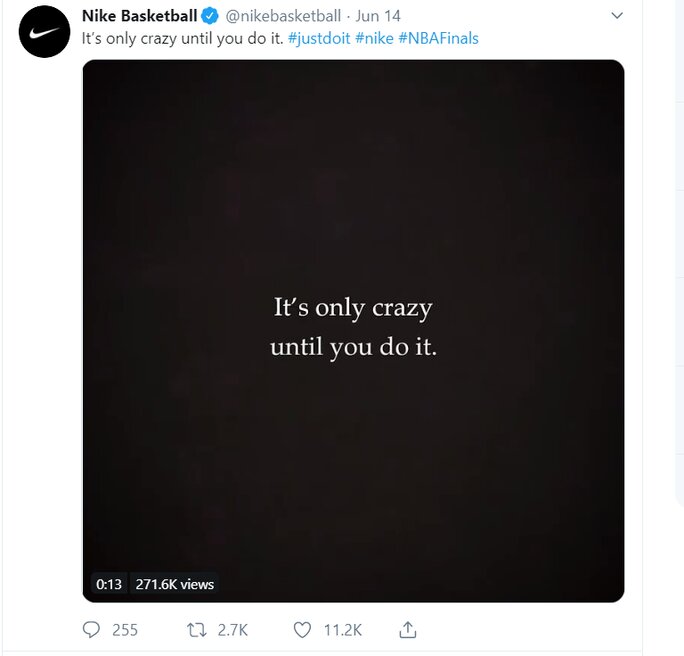
Nike’s social media campaigns have tapped into important social issues. They built a strong relationship with their customers and brilliantly turned their own slogan into a call-to-action.
They encourage readers to #JustDoIt when interacting with their customers. The ‘it’ depends on the viewer, but Nike’s invite becomes a call-to-action to challenge yourself, and to engage and share your journey with them.
How can you add a call-to-action to your own slogans and taglines? This could take some testing. Brainstorm a few copies to tap into the right tone and language for your brand.
And, if you want to add a strong CTA to your social media posts, use the SocialPilot Free Post Generator Tool.
7. Stimulate activism: TOMS

TOMS values the importance of social responsibility. They know how to interest their followers with conscious offers, like these butterfly-inspired limited edition shoes produced in collaboration with the Environmental Defense Fund.
Rather than focusing on the ‘Buy Now’ part of the CTA, TOMS focuses on the social connection and softens the traditional call-to-action with a ‘Learn more and shop’ option.
The reality is, everybody feels over-saturated by ads these days. TOM’s limited focus on a core customer value and gentle sales pitch that doesn’t guilt or pressure is refreshing.
Take a look at your brand and see if you can offer a chance to ‘Learn More’ coupled with a good cause, rather than moving right to the sales pitch.
8. Inspire to give: Coca-Cola
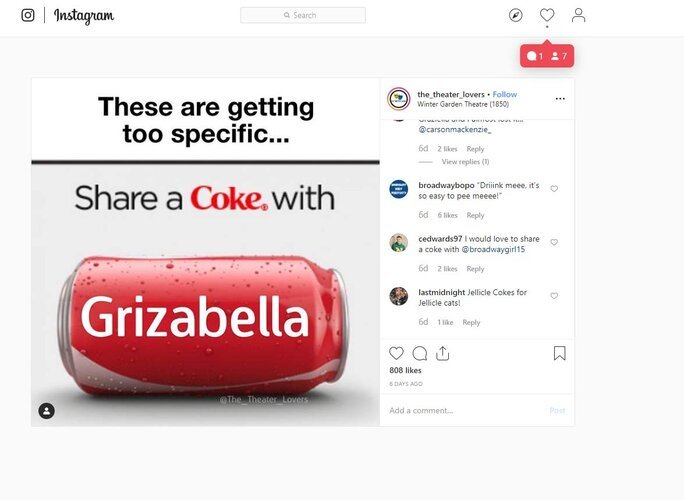
Coke was among the first companies to adopt a solid social media strategy. As such, it’s a company you could learn a lot from, even when you’re nowhere near that size. The ‘Share A Coke’ campaign is a great example of the best call-to-action tips. It’s visual, available on multiple platforms, and allows for a sense of community.
It doesn’t use the sales language, but rather invites. However, it does prompt people to actually buy a Coke. But not for yourself, for someone you care about. Smart!
The smash-hit marketing campaign resulted in expansion from the original 250 names to 1000 and allowed Coke to sit back and let its customers create its own content. Currently, it’s going even further, giving customers a chance to get personalized bottles and even sell the name stickers via an online store.
One of the reasons the ‘Share A Coke’ call-to-action worked so well was that it built a sense of community. Rather than persuading someone to learn or buy something, Coke’s unique call-to-action invited you to connect with the company, the product, and everyone else.
Creating engagement through fun questions and responses to comments is one kind of sharing. Finding a way to share an experience with your customers can foster a sense of community and customer loyalty.
9. Show yourself: Dove

Women’s issues are taking the forefront in our conversations more than ever before. Dove is taking advantage of this interest in women’s lives, promoting, inspiring women on their social media, and offering customers the chance to learn more.
They’ve created the #ShowUs campaign in collaboration with Getty Images, where women are asked to show their perception of a woman. It resulted in a lot of user-generated content. The call-to-action is to sign a petition against sexist terms in the Oxford Dictionary.
The lesson here is that it can’t always be about business.
Sometimes, your call-to-action needs to focus on brand values and providing quality content. The result will indirectly attribute customers to place your product above your competition because they align with your values.
SocialPilot, a social media management tool, has a custom CTA button that can be added to your organic Facebook and GMB posts! Like you saw, CTAs help you grab your audience’s attention and result in improved conversions.
Here’s an example of how you can add a CTA to your Facebook post.
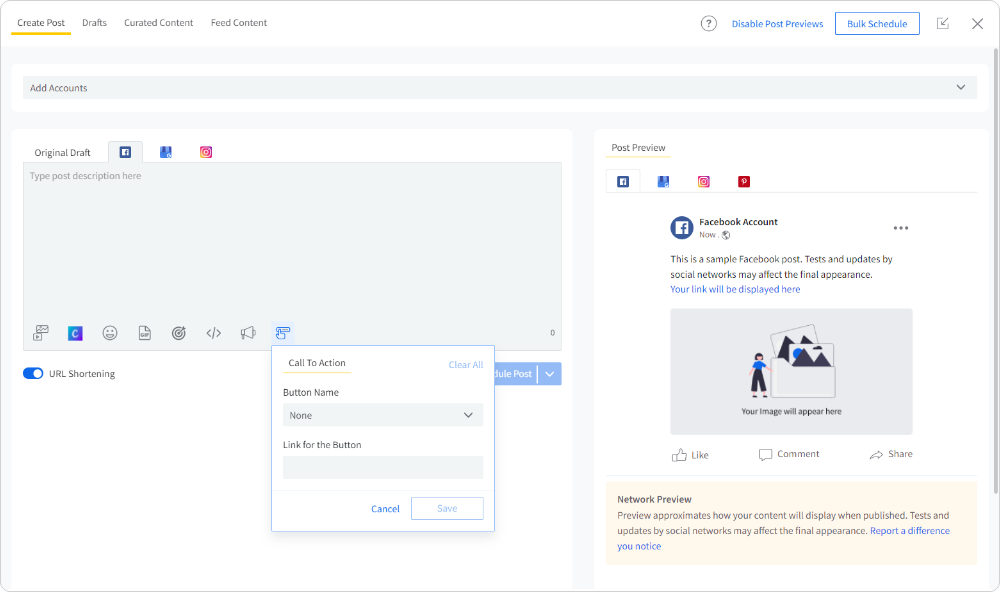
Just click on the ‘Call To Action’ button to select the desired CTA from the dropdown list. Add the link to the destination site and click on the Apply button to save it.
Wrapping Up
Create multiple copies of CTA to target different segments of the audience. You need to walk them through your sales funnel. So consider using CTA for every stage of your social media marketing strategy. You can even use buyer personas to understand the scenarios for their application better.
Think about the language you’re using, the goals you have for your posts and campaigns. Who will benefit from your product, and what would help them make the right choice?
And of course, you shouldn’t stop marketing after you post. Experiment with posting times and copy lengths. Always analyze your social media posts to know what is working best for you and what needs improvement. With SocialPilot’s analytics feature, you can easily gain detailed insights into your social media performance. Take up its free trial and devise strategies for better conversion.




